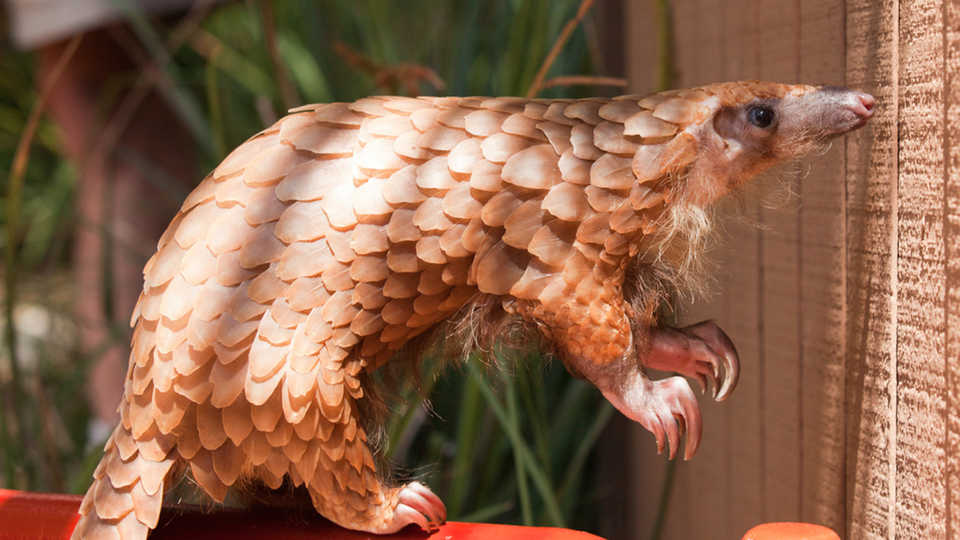Science News
Monday Bites: Pangolins, Animal Brains, and Belugas
Enjoy some morsels of recent animals news…
Tracking Pangolin Disappearance
Last week we reported on how scientists are using DNA tools to track poached ivory to its place of origin. With these tools, conservation organizations are hoping to stop elephant poaching at the source—or at least use DNA as evidence to bring down illegal ivory trafficking.
This technique was established by Samuel Wasser at the University of Washington and now a student in his lab is using the same method for pangolins. At the recent American Association for the Advancement of Science (AAAS) Annual Meeting, Hyeon Jeong Kim explained how these strange-looking animals—actually mammals “that feed on termites and ants, and whose hair has been turned into scales,” native to Asia and Africa—are being poached for their meat and scales. (Many people believe that the scales help lactation, acne, cancer, and more but actually have no medical properties at all.) Wasser confirmed that pangolins are “the most poached animal in world right now.”
“The seizures are larger than some of the larger ivory seizures,” Kim explained. “There were 2,600 in one seizure. The animals are nocturnal and elusive, so it’s hard to even know what is out there [numbers and populations], where are they coming from and how quickly are being decimated,” she continued.
Using the DNA technique, she’s hoping to collect data on pangolins in a quick way, creating a reference map and genetic markers of all eight species that she can share with other labs. “The goal is to save pangolins, save them before it’s too late.”
Large Brains and Extinctions
Earlier this month, we wrote about benefit of larger brains in mammals. Turns out the bigger the brain in relation to body size, the more intelligent the animal. But it may not all be good news for these bigger brained-species. In a recent study in Proceedings of the Royal Society B, Stanford researcher Eric Abelson found that relative brain size is correlated with the endangerment status of modern mammals.
The finding comes as something of a surprise to Abelson. “If the landscape becomes colder, an animal might not be able to grow dense fur, but these animals can problem-solve,” he says. “They might use cognition to overcome a colder environment by building a warmer nest, or choosing to spend more time in the sun.”
But there’s a tradeoff to these benefits. Neural tissue is incredibly expensive to grow and support, so the animal has to eat more or spend fewer calories doing other things.
This expense, Abelson said, might expose such animals to a bigger hit from the other pressures typically related to extinction, such as resource scarcity. Or there might simply be scenarios that a relatively larger brain can’t out-think—a bigger brain, for instance, may not help an aquatic animal that lives in polluted waters.
Abelson hopes the discovery could help design more effective conservation strategies, particularly for big-brained species, or help identify at-risk mammals.
Beluga Dives
Between 1997 and 2012, researchers used satellite tags to study elusive beluga whales in the Arctic. A University of Washington team followed two distinct populations of the cetaceans that spend winters in the Bering Sea and move north as sea ice melts and open water allows them passage into the Beaufort and Chukchi seas.
Collaborating with native populations along the coast of Alaska and Canada, the scientists tagged 30 whales to create this rare dataset that spans 15 years of diving and migration patterns. “It’s a really fantastic system for getting relatively high-resolution information for these animals that spend most of their time underwater and offshore,” says Donna Hauser, author of a recent publication of the data. “In addition to their inaccessibility, these populations use remote areas of the Arctic, so they are generally hard animals to research.”
Hauser and her colleagues determined that the beluga whales are frequently diving to depths of 200 to 300 meters (660 to 990 feet)—and sometimes over 900 meters (nearly 3000 feet)—to find food. The team studied the belugas’ favorite prey, Arctic cod, too, and discovered the fish at similar depths.
“This study gives us a benchmark of the distribution and foraging patterns for these two beluga populations,” Hauser says. “However, there still needs to be additional work to see how beluga behavior has changed in concert with changing sea ice conditions in the Arctic.”
Image(s): Ruslan Rugoals/Flickr and Kristin Laidre/University of Washington

